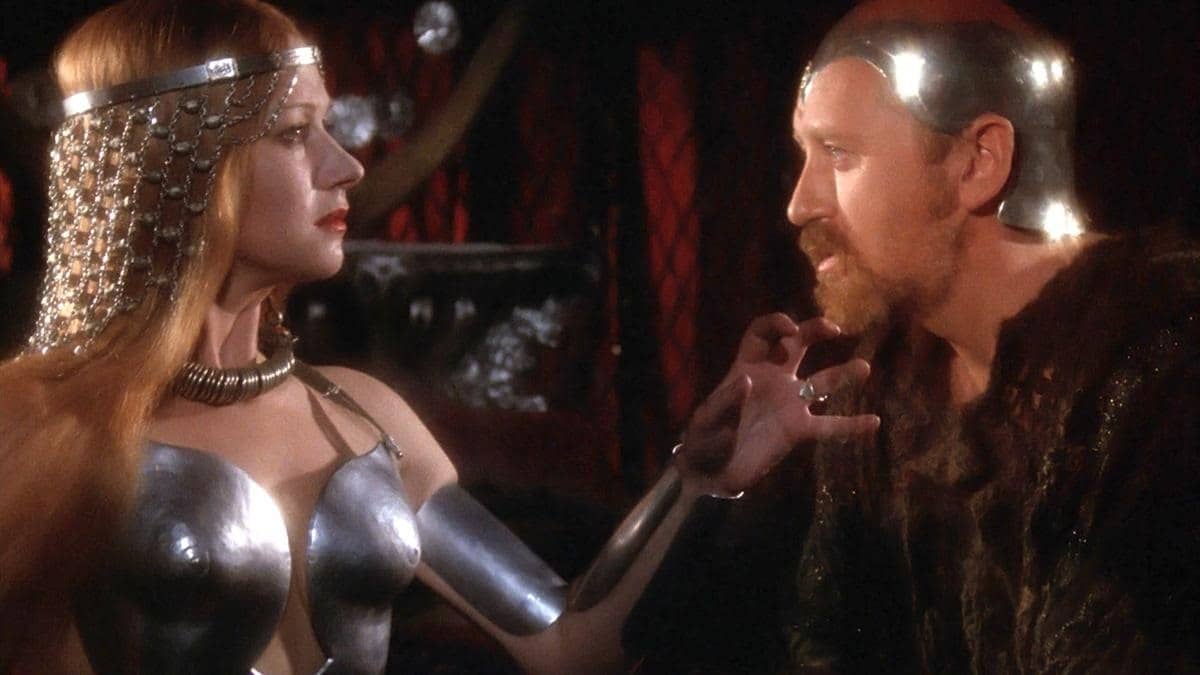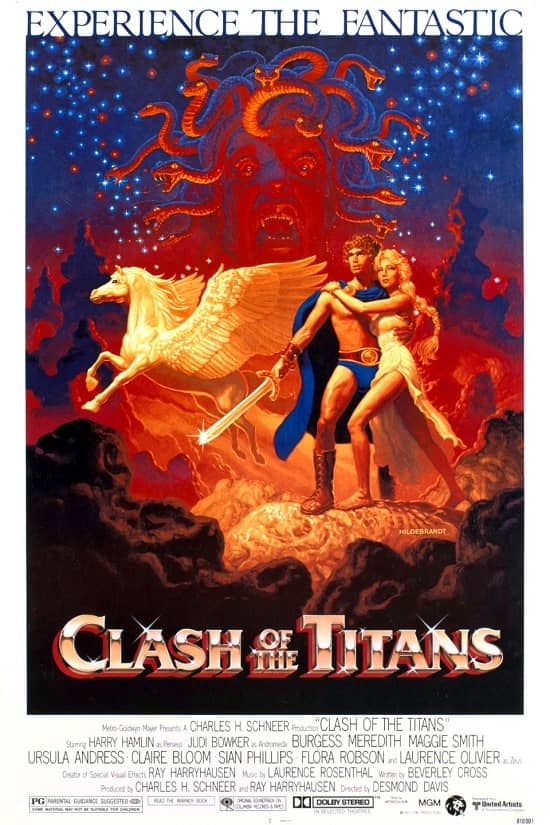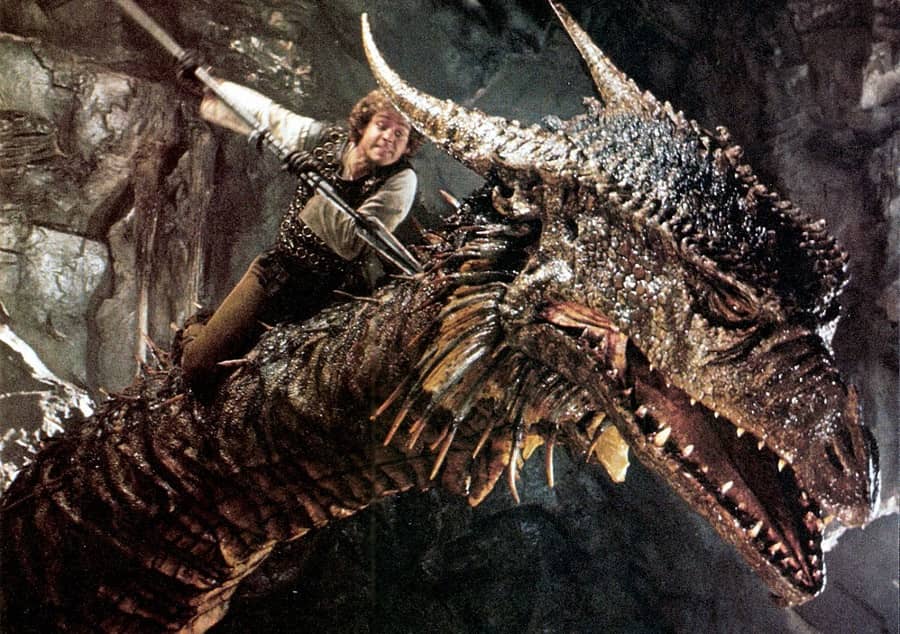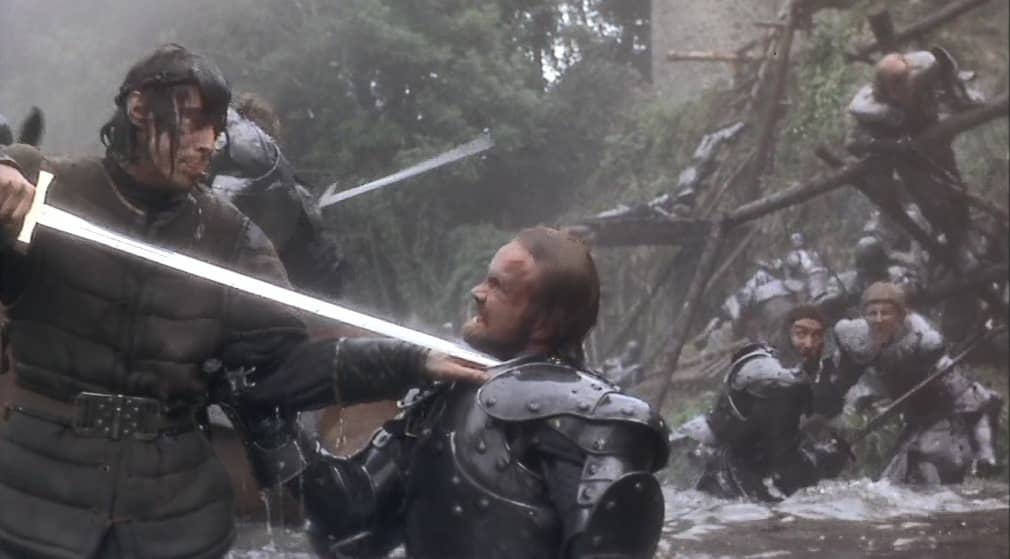Ellsworth’s Cinema of Swords – 1981: The Old Order Changeth
Excalibur (Warner Bros, 1981)
1981 was a watershed year in fantasy films. The success of Star Wars had made it possible to fund and produce large-scale SF and fantasy movies, but it also heralded a change in the way such movies were made, placing high-quality (and thus expensive) special effects front and center. Prior to Star Wars, special effects in fantasy films were almost invariably low-budget and cheesy, reflecting movie producers’ almost invariable belief that such films appealed only to a niche and rather undiscerning market.
The conspicuous exception to this rule was the films of master animator Ray Harryhausen, but even in his movies, beyond the creature animation, the production values, script, and human performances were often afterthoughts. However, the creatures were magnificent, and that was considered enough.
Not anymore. Harryhausen’s painstaking stop-motion animation had been superseded by new approaches that integrated stop-motion with puppetry, classical animation, and most importantly computer graphics. And indeed, 1981’s Clash of the Titans was Harryhausen’s final film. If Clash wasn’t completely outdone by Dragonslayer, the effects in that film, largely produced by George Lucas’ Industrial Light and Magic, nonetheless pointed the way toward a new era in fantasy.
However, it wasn’t all about the special effects. John Boorman’s Excalibur showed that a film of heroic fantasy could also be cinematic art, aspiring to the best the medium was capable of. After Excalibur, plenty of critics would continue to sneer at fantasy films, but the proof was in: they were wrong.
Clash of the Titans (1981)
Rating: ****
Origin: UK/USA, 1981
Director: Desmond Davis
Source: Warner Bros. Blu-ray
There are worse ways to learn about Greek myths than from a Ray Harryhausen adventure film. This time the great stop-motion animator takes on the story of Perseus and Andromeda, with his fantastic creatures, such as Pegasus, Medusa, a mechanical owl, and some angry giant scorpions, as usual out-acting the human players, though this time not by much.
There are some changes to the tale of the myth to make the story hang together better as a movie script, but the basics are intact: Queen Cassiopeia (Siân Phillips, Livia from I, Claudius), makes the mistake of praising her daughter Andromeda (Judi Bowker) as more beautiful than the sea goddess Thetis (Maggie Smith), and the divine lady vows revenge, threatening to send the monstrous Kraken to destroy their city within thirty days. But the hero Perseus (Harry Hamlin) falls in love with Andromeda and vows to save her. As a son of Zeus (Laurence Olivier), Perseus is granted the best god-forged gear, a sword-and-magic-helmet (plus shield) that are just what you want for monster fighting. But he’s going to need more than that to defeat the Kong-sized Kraken, so he goes on a quest to ask the creepy Three Stygian Witches what to do. After stealing their single eye to get the witches to talk, Perseus is advised that his only chance is to travel to the Isle of the Dead on the edge of the Underworld and there to take the head of the gorgon Medusa. On it!
The plot is thickened with the addition of some extra characters not in the original myth, including the devilish Calibos (well played by Neil McCarthy), who also desires Andromeda, the aforementioned Pegasus the flying horse, and the giant scorpions, who provide the best swordplay foils in the film. There’s also a cutesy mechanical owl made by Hephaeustus in imitation of Athena’s favorite familiar and sent to help Perseus after he loses his magic helmet in a haunted swamp. Best of all is Medusa, and the scene in which Perseus and his hoplite redshirts invade her eerie flame-lit temple is tense and suspenseful.
For a Harryhausen epic, the human actors come off pretty well. Romantic leads Hamlin and Bowker are more than just pretty faces, dealing well with the lean script by Beverley Cross, and Burgess Meredith does a pleasant turn as Perseus’ poetic sidekick Ammon. The role of the gods of Olympus is even more prominent this time than in Jason and the Argonauts (1963), the divinities pushing mortals around like pieces on a game board, and it’s clear that even the villains like Calibos and Medusa were made into monsters by the whims of the gods.
But times are changing, and this is the last of Harryhausen’s stop-motion animated fantasy films. In 1981 Star Wars is the new leading fantasy franchise, and its influence is felt in the John Williams-inspired soundtrack by Laurence Rosenthal and by the vocalizations of the mechanical owl, which are all too similar to the whistles, clicks, and beeps of R2D2. But Clash was nonetheless a success, beaten out that year only by Raiders of the Lost Ark, which was released on the same day — not a bad swan song for the venerable Harryhausen. And, of course, this film is the source of the “Release the Kraken!” meme. But did you remember that the original line was spoken by Sir Laurence Olivier?
Dragonslayer
Rating: ****
Origin: USA, 1981
Director: Matthew Robbins
Source: Paramount DVD
Dragonslayer is one of the few early Eighties fantasy films that has improved with age. At the time its rather dark vision was a shock to mainstream audiences, especially in a film co-produced by Disney, but by the standards of our current day it’s damn near lighthearted.
In Urland, a fictional kingdom somewhere in Britain in the 6th century, one of the last of the race of dragons, Vermithrax Pejorative, terrorizes the countryside until the king institutes a lottery selecting virgin sacrifices, one young woman chosen every six months to sate the dragon’s hunger. But the sacrifices are always borne by the peasant class, so a band of fed-up commoners led by a young man named Valerian (Caitlin Clarke) sets out to persuade Ulrich (Ralph Richardson), the last of the great wizards, to slay the dragon. However, the band has been followed by the king’s hatchet man, the ruthless Tyrian (John Hallam), who is determined that no one will meddle with Urland’s precarious détente with the dragon. Tyrian challenges Ulrich’s magical credentials and the wizard defies him, offering his breast and daring Tyrian to try to kill him with a wicked dagger. Alas, the dagger goes home, and the wizard falls, leaving the quest in the hands of Ulrich’s young and inexperienced apprentice, Galen (Peter MacNicol).
Galen, armed with nothing but overconfidence and his late master’s magical amulet, sets out to kill the dragon along with Valerian, whom he discovers is a young woman her father had passed off as a man to avoid the dragon lottery. Cue the seemingly doomed romance! The film is shot in the magnificently austere landscape of North Wales, which along with a grimly dramatic soundtrack by the great Alex North gives the film a tone of dark portent, a tone alleviated only by Galen and Valerian’s emerging love for one another and the young apprentice’s heroic determination to try to slay the dragon regardless of consequences. The script, by director Matthew Robbins and producer (and video game designer) Hal Barwood, is taut and literate, and the cast is solid, particularly Ralph Richardson, who was born to play a medieval wizard.
However, the most important member of the cast is arguably the dragon Vermithrax, though it speaks only by breathing fire on its opponents. Robbins and Barwood set out to create the finest dragon anyone had put on film to that date, and by most measures they succeeded: Vermithrax, a combination of large-scale puppetry with stop-motion and classical animation, is scary and convincing. The dragon’s final visuals were realized by George Lucas’ effects studio Industrial Light and Magic, one of their early efforts lending their talents to non-Lucas productions. The dragon’s savage young, rendered by puppets, are less successful than the parent, and the overwrought wizardry of the finale is more pompous than persuasive, but those are nitpicks. It’s remarkable that this film got made as well as it did when it did, and its practical effects hold up remarkably well against the computer-generated graphics of later decades. Give it a look.
Excalibur
Rating: *****
Origin: USA, 1981
Director: John Boorman
Source: Warner Bros. DVD
In the late 1470s, English knight Thomas Malory decided to collect all the major Arthurian stories in French, Welsh, and English, put them into a coherent order and retell them as the book Le Morte Darthur. In the late 1970s, English director John Boorman decided to collect all the major incidents of Malory’s book and retell them as a visionary feature film. Both efforts were ambitious to the point of madness, and yet both were resoundingly successful.
Filming Malory meant making changes to adapt to the medium of cinema, of course, and Boorman and co-writer Rospo Pallenberg decided to focus the story on King Arthur’s legendary sword Excalibur, bringing it onstage before Malory did and investing it with mystical significance beyond what it had in the Morte. The other major decision was to expand the part of the wizard Merlin, making him more central to the story and keeping him around longer than in Malory. Both choices strengthened the movie’s core narrative.
The resulting film is long and episodic, like the book, but it hangs together, and most important considering it’s a movie, it looks fabulous. Shot in the lush forests of Ireland’s County Wicklow, it’s drenched in saturated color, vivid and magical. The sumptuous costumes are exaggerated fantasies of medieval clothing, like opera costumes, an approach that works well against a sonic backdrop of soaring music by Wagner and Carl Orff.
And the acting is a treat. King Arthur is played by classically trained Nigel Terry, who portrays him from his teens to his fifties, but the film really revolves around the rivalry between sorcerers Merlin and Morgana, memorably played by Nicol Williamson and Helen Mirren. Williamson in particular is not your father’s comfortable old Merlin, he’s strange, speaking his lines in a high, sing-song pattern that gives his gnomic pronouncements uncanny significance. In addition, Nicholas Clay and Cherie Lunghi practically glow as Lancelot and Guenevere, and even the minor roles are filled by soon-to-be heavyweights like Patrick Stewart, Liam Neeson, and Gabriel Byrne.
The dialogue is mostly simple and direct, avoiding florid ye-olde-knightspeak, allowing the imagery to carry most of the storytelling weight. The story itself stretches from Arthur’s conception in an act of adultery enabled by Merlin’s magic, through his youth drawing the sword from the stone, gathering Lancelot to his side, marrying Guenevere, and founding Camelot and the brotherhood of the Round Table. The knightly combats, orchestrated by fight director William Hobbs, are taut and exciting, particularly during the period of Arthur’s early struggles. The story lags a bit during the Grail Quest, as it does in the book, but Boorman ties the holy relic back into the tale of Arthur, reviving him in time to face the threat of Mordred, his evil son conceived in sorcerous sin on his half-sister Morgana, echoing Arthur’s own conception. The Christian mysticism never impedes the drive of the story much, and in the finale Boorman raises the tone to epic without going too far into ponderous.
In short, this is the best cinematic adaptation of Le Morte Darthur made up to its time, and as of current date it still hasn’t been topped. If you haven’t seen it, you have a memorable evening ahead of you.
Where can I watch these movies? I’m glad you asked! Many movies and TV shows are available on disk in DVD or Blu-ray formats, but nowadays we live in a new world of streaming services, more every month it seems. However, it can be hard to find what content will stream in your location, since the market is evolving and global services are a patchwork quilt of rights and availability. I recommend JustWatch.com, a search engine that scans streaming services to find the title of your choice. Give it a try. And if you have a better alternative, let us know.
Previous installments in the Cinema of Swords include:
Lone Wolf and Cub, Part I
Premium Peplum
The Book Was Better
Shogunate’s End
Peak Musketeers
Lone Wolf and Cub, Part 2
Arthur, King of the Britons
Sinbads Three
Premium Peplum: Top Hercs
Fight Direction by William Hobbs
Mash-Up or Shut Up
Classics on Screen — 1977
Wuxia in the Time of Kung Fu
So Many Prisoners of Zenda
Seventies Hall of Shame
The Year of Shogun
LAWRENCE ELLSWORTH is deep in his current mega-project, editing and translating new, contemporary English editions of all the works in Alexandre Dumas’s Musketeers Cycle, with the fifth volume, Between Two Kings, coming in July from Pegasus Books in the US and UK. His website is Swashbucklingadventure.net.
Ellsworth’s secret identity is game designer LAWRENCE SCHICK, who’s been designing role-playing games since the 1970s. He now lives in Dublin, Ireland, where he’s writing Dungeons & Dragons scenarios for Larian Studios’ Baldur’s Gate 3.




Three classics of the first water! I remember seeing both Clash and Dragonslayer in the theater back in the day, although Excalibur would have to wait some few years before I could watch it (pesky R rating).
I also had (and read repeatedly) Marvel Comics’ 2-issue Dragonslayer adaptation.
Now we just need all three of these released on 4K HDR disc ASAP.
I remember loving Excalibur back in the day, but found it almost unwatchable when I recently returned to it. Dishes that are overheated to begin with tend to spoil quickly.
Ah Excalibur. The film that set me on the path of fantasy. I still return to it occasionally. Clash is also a classic with so many clever bits, always enjoys a re-watch. Oddly enough only saw Dragonslayer once o twice and don’t recall much about it, maybe i should try lay my hands on it and give it another go. Looking forward to what is to come Lawrence.
PS – Any Clash of the Titans fan has to look up a short CGI movie called Rebooted, it is on YouTube
Vermithrax Pejorative, “The Worm from Thrace That Makes Things Worse”, a name from 1981 that I never have forgotten. It is hard for me to think of “Dragonslayer” as ‘light-hearted’, but I do confess that cinema has darkened muchly in the past 40 years. Time for a re-watch, methinks.
And maybe another watch of “Excalibur”? I remember liking the acting and most of the character choices, even if Arthur (Nigel Terry) struck me as a bit too “snotty-nosed” when getting Excalibur. And the Wagnerian operatic vibe was stronger than I would prefer in my Celtic myths. But, again, 40 years and all …
Another Ellsworth’s Cinema of Swords? And three of the best at that!
I remember liking Dragonslayer when it came out but Clash and Excalibur are the films that I have returned to again and again over the years. Clash of the Titans is just fun and Excalibur haunts me with its colorful imagery and the scope of its story. Ambitious to the point of madness indeed.
Thank you Mr. Ellsworth!
finally getting to movies i have seen :p hahaha
would love to waych some of the old ones in this series but who has the time haha
I love Dragonslayer and was happy when I showed it to my nephews they dig it. I definitely need to research Excalibur in all its messy glory
Seen these all, love them but especially “Excalibur”!
Ah, “My kingdom for a Can-Opener!”
Seriously, I think Excalibur is the best in that somehow they managed to capture at least a good taste of the essence of the “Arthurian” mythos. Tons of movie, comics, etc. about that ancient king but most were in the early to mid century cinema past where King Arthur was a huge staple of culture and especially young boys ideal characters. Thus the early films were making good film adaptations of a specific story to those that knew and could appreciate it.
Sadly towards the 80s this had become both less a staple and deconstructionist – so kids grew up without reading King Arthur until at best College where some ‘professor’ tried to dryly throw a brick of an expensive intellectual reading only book at their mouth hoping to chip teeth and of course the parodies (“it’s a rabbit with big, pointy teeth!”) set in and had a derisive effect versus a legitimate jest. Not bashing Monty, I bet IRL King Arthur would have said “I wish I had that Holy Hand grenade in (name a specific battle), but luckily I’ve not encountered rabbits as such…” then go to in the spirit of “Fun” give him a little “oppression”… However this was by far the kindest as too many were trying to downgrade him to some myth.
Enter the “Modern” world the 80s and with King Arthur well known but few if any intimate with his tales – how DO you make a movie about it? The Arnie Conan movie had a similar problem – Conan was an excellent fantasy character but if you didn’t know him some tales might be off-putting. The challenge to either movie would be how to draw in readers to like the movie and get into the character’s larger story. To a Newbie it can be daunting, the proper mythology is a week of reading – back in the day the “Bards” told the tale over two weeks. Thus the movie treatment faces a hard wall – either a specific story or a criminal cutting. Many have tried, most have grossly failed. Rick Wakeman bankrupted himself with a musical version but Prog Rock at its craziest (on ICE) did a great job – might search on YouTube: “Rick Wakeman – Lancelot And The Black Night (Live) (Promo Only)” the singer for this is perfect…!
For this movie – Excalibur, I think they should have let this guy work on DUNE vs Lynch. Criminally short versus any fair amount of time but this movie – My very strong opinion – does capture the magic of the Arthurian legends as a whole despite low time. Again 14 hours Jodorowsky would have liked for DUNE…nothing in comparison. Save “Camelot” there’s not really much more out there for a whole experience for ‘newbies’ in a movie. Tons of good movies about a specific story (“Sword of the Valiant”) or based on it, ahem Prince Valiant by Hal Foster, but encapsulating…?
Going forward I think “Camelot 3000” should be turned into the next movie that touches on him – not a direct adaptation but would work in the modern world and get people interested in the real King Arthur. SUPER “Progressive” (and daring, sometimes banned in its times) so the various forced ‘changes’ they make are already there – but the spirit of the story, the return of King Arthur in some far future date catch right on. Oh, and I dub mineself “Master of Thine Obvious” more kids should be read Arthur, Robin Hood, Greek Myths…
I don’t think any Arthurian movie before and especially since has come close to Boorman’s Excalibur.
True story, a co-worker of mine who often mocks me for my love of 80s movies, once approached me about if this Disney movie “Dragonslayer” would be a good thing for him to watch with his young daughters. I did not hesitate to tell him “yes”.
He didn’t speak to me for a week!